Analyzing Trade Union Influence: A Case Study of Serve Corporation
VerifiedAdded on 2020/06/04
|10
|3251
|37
Case Study
AI Summary
This case study examines the challenges faced by Serve Corporation due to the influence of trade unions. The report analyzes the role of trade unions, their relevance in today's workplace, and the impact of industrial actions such as strikes. It discusses the unitarist and pluralist approaches to management, evaluating their suitability for the organization. The case study highlights the negative impacts of trade union activities on the company's productivity and employee relations, particularly focusing on the UTR trade union's influence. The analysis covers various forms of industrial action, assessing their effectiveness and suitability in addressing employee demands and grievances. The report emphasizes the importance of harmonious relations between the company, trade unions, and workers to ensure a productive work environment and achieve organizational goals. The study concludes with recommendations for the company to adopt the pluralist approach to foster better employee relations and maximize productivity, ultimately enabling the organization to achieve its objectives and increase revenue.
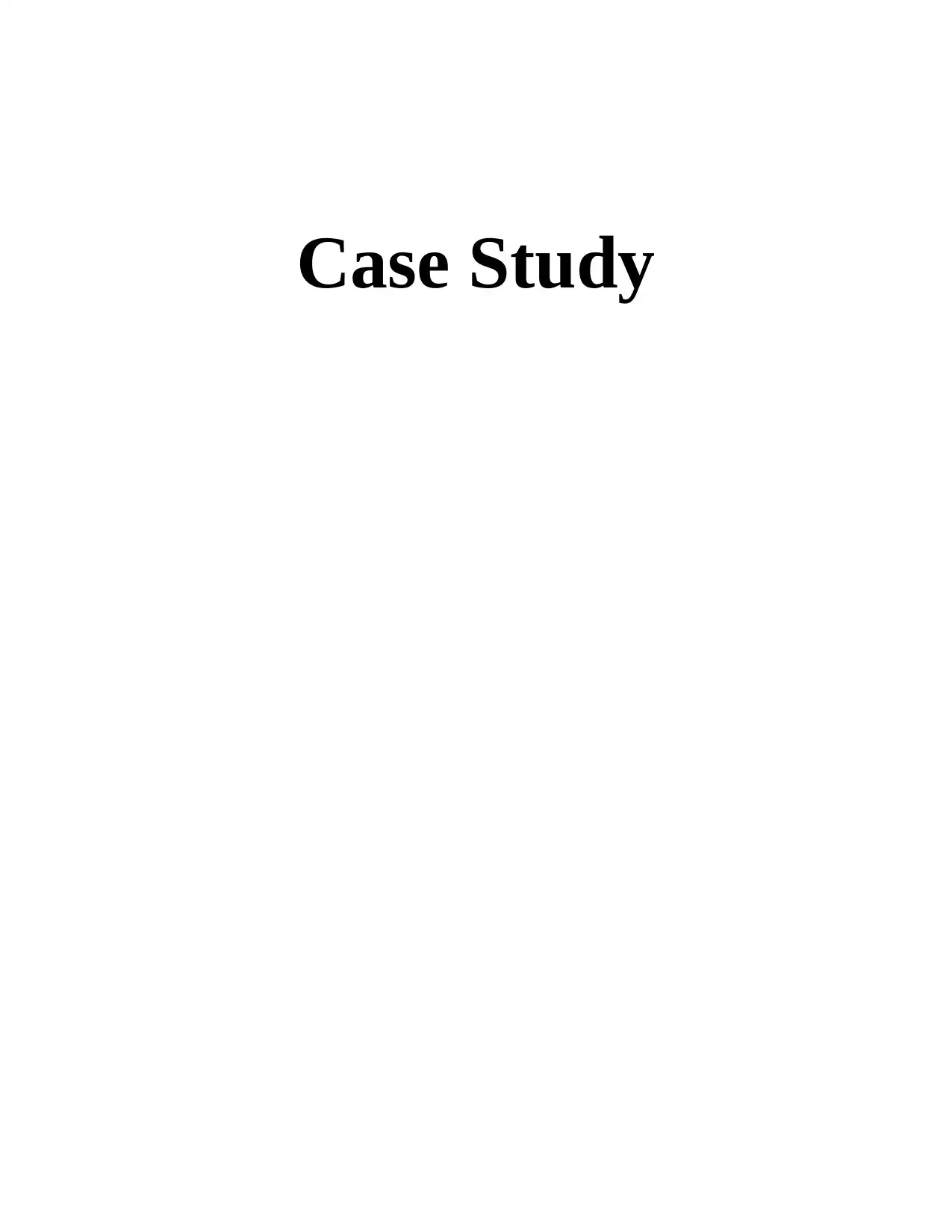
Case Study
Paraphrase This Document
Need a fresh take? Get an instant paraphrase of this document with our AI Paraphraser
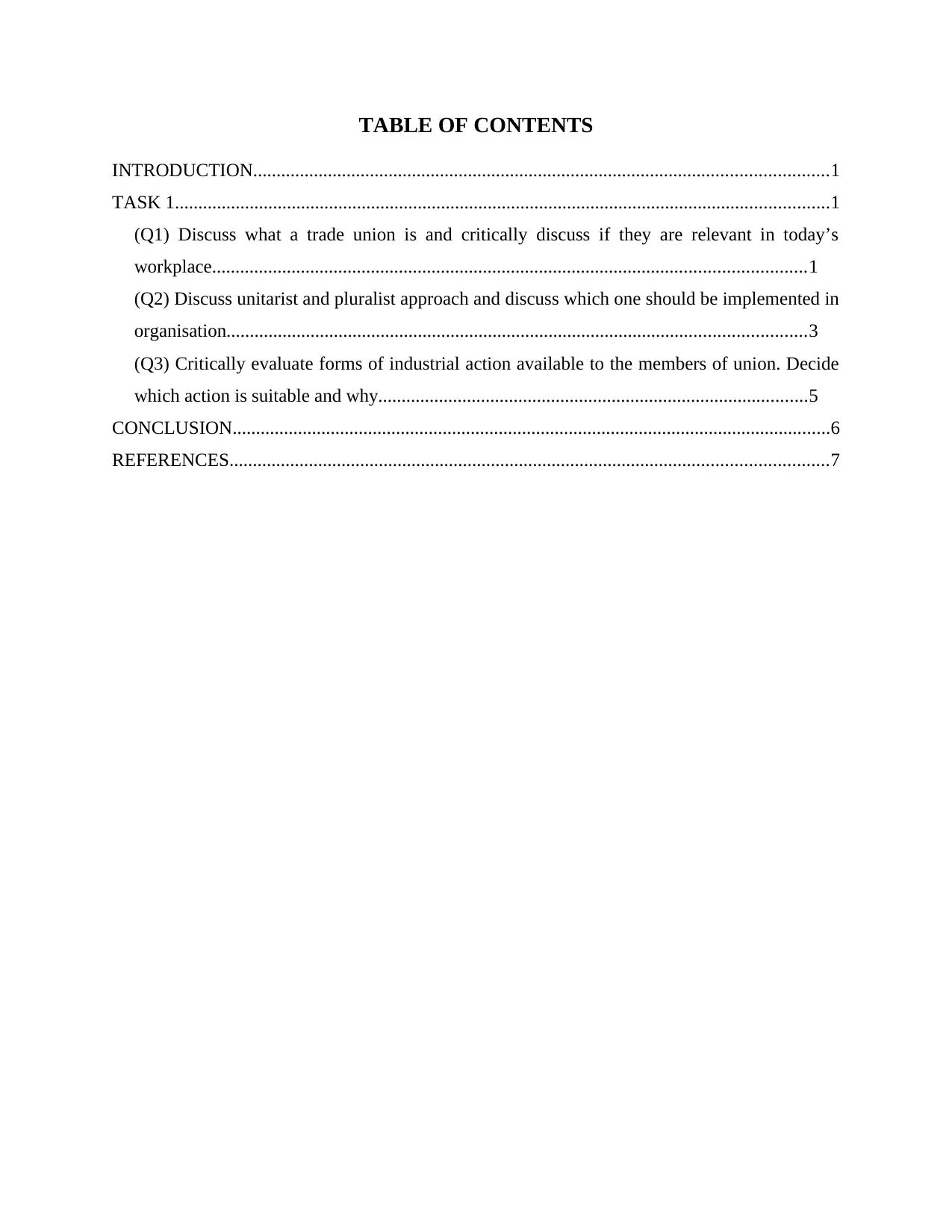
TABLE OF CONTENTS
INTRODUCTION...........................................................................................................................1
TASK 1............................................................................................................................................1
(Q1) Discuss what a trade union is and critically discuss if they are relevant in today’s
workplace...............................................................................................................................1
(Q2) Discuss unitarist and pluralist approach and discuss which one should be implemented in
organisation............................................................................................................................3
(Q3) Critically evaluate forms of industrial action available to the members of union. Decide
which action is suitable and why............................................................................................5
CONCLUSION................................................................................................................................6
REFERENCES................................................................................................................................7
INTRODUCTION...........................................................................................................................1
TASK 1............................................................................................................................................1
(Q1) Discuss what a trade union is and critically discuss if they are relevant in today’s
workplace...............................................................................................................................1
(Q2) Discuss unitarist and pluralist approach and discuss which one should be implemented in
organisation............................................................................................................................3
(Q3) Critically evaluate forms of industrial action available to the members of union. Decide
which action is suitable and why............................................................................................5
CONCLUSION................................................................................................................................6
REFERENCES................................................................................................................................7
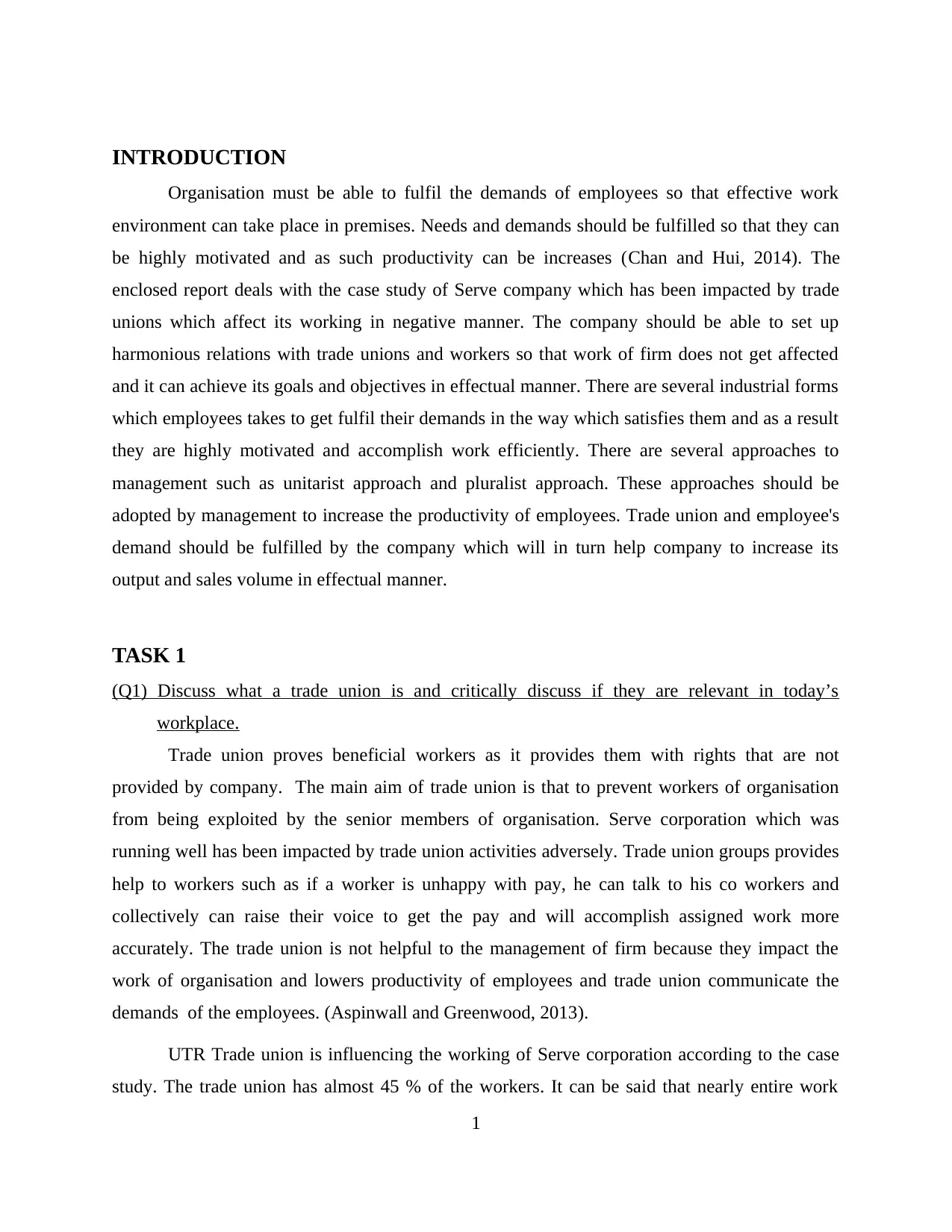
INTRODUCTION
Organisation must be able to fulfil the demands of employees so that effective work
environment can take place in premises. Needs and demands should be fulfilled so that they can
be highly motivated and as such productivity can be increases (Chan and Hui, 2014). The
enclosed report deals with the case study of Serve company which has been impacted by trade
unions which affect its working in negative manner. The company should be able to set up
harmonious relations with trade unions and workers so that work of firm does not get affected
and it can achieve its goals and objectives in effectual manner. There are several industrial forms
which employees takes to get fulfil their demands in the way which satisfies them and as a result
they are highly motivated and accomplish work efficiently. There are several approaches to
management such as unitarist approach and pluralist approach. These approaches should be
adopted by management to increase the productivity of employees. Trade union and employee's
demand should be fulfilled by the company which will in turn help company to increase its
output and sales volume in effectual manner.
TASK 1
(Q1) Discuss what a trade union is and critically discuss if they are relevant in today’s
workplace.
Trade union proves beneficial workers as it provides them with rights that are not
provided by company. The main aim of trade union is that to prevent workers of organisation
from being exploited by the senior members of organisation. Serve corporation which was
running well has been impacted by trade union activities adversely. Trade union groups provides
help to workers such as if a worker is unhappy with pay, he can talk to his co workers and
collectively can raise their voice to get the pay and will accomplish assigned work more
accurately. The trade union is not helpful to the management of firm because they impact the
work of organisation and lowers productivity of employees and trade union communicate the
demands of the employees. (Aspinwall and Greenwood, 2013).
UTR Trade union is influencing the working of Serve corporation according to the case
study. The trade union has almost 45 % of the workers. It can be said that nearly entire work
1
Organisation must be able to fulfil the demands of employees so that effective work
environment can take place in premises. Needs and demands should be fulfilled so that they can
be highly motivated and as such productivity can be increases (Chan and Hui, 2014). The
enclosed report deals with the case study of Serve company which has been impacted by trade
unions which affect its working in negative manner. The company should be able to set up
harmonious relations with trade unions and workers so that work of firm does not get affected
and it can achieve its goals and objectives in effectual manner. There are several industrial forms
which employees takes to get fulfil their demands in the way which satisfies them and as a result
they are highly motivated and accomplish work efficiently. There are several approaches to
management such as unitarist approach and pluralist approach. These approaches should be
adopted by management to increase the productivity of employees. Trade union and employee's
demand should be fulfilled by the company which will in turn help company to increase its
output and sales volume in effectual manner.
TASK 1
(Q1) Discuss what a trade union is and critically discuss if they are relevant in today’s
workplace.
Trade union proves beneficial workers as it provides them with rights that are not
provided by company. The main aim of trade union is that to prevent workers of organisation
from being exploited by the senior members of organisation. Serve corporation which was
running well has been impacted by trade union activities adversely. Trade union groups provides
help to workers such as if a worker is unhappy with pay, he can talk to his co workers and
collectively can raise their voice to get the pay and will accomplish assigned work more
accurately. The trade union is not helpful to the management of firm because they impact the
work of organisation and lowers productivity of employees and trade union communicate the
demands of the employees. (Aspinwall and Greenwood, 2013).
UTR Trade union is influencing the working of Serve corporation according to the case
study. The trade union has almost 45 % of the workers. It can be said that nearly entire work
1
⊘ This is a preview!⊘
Do you want full access?
Subscribe today to unlock all pages.

Trusted by 1+ million students worldwide
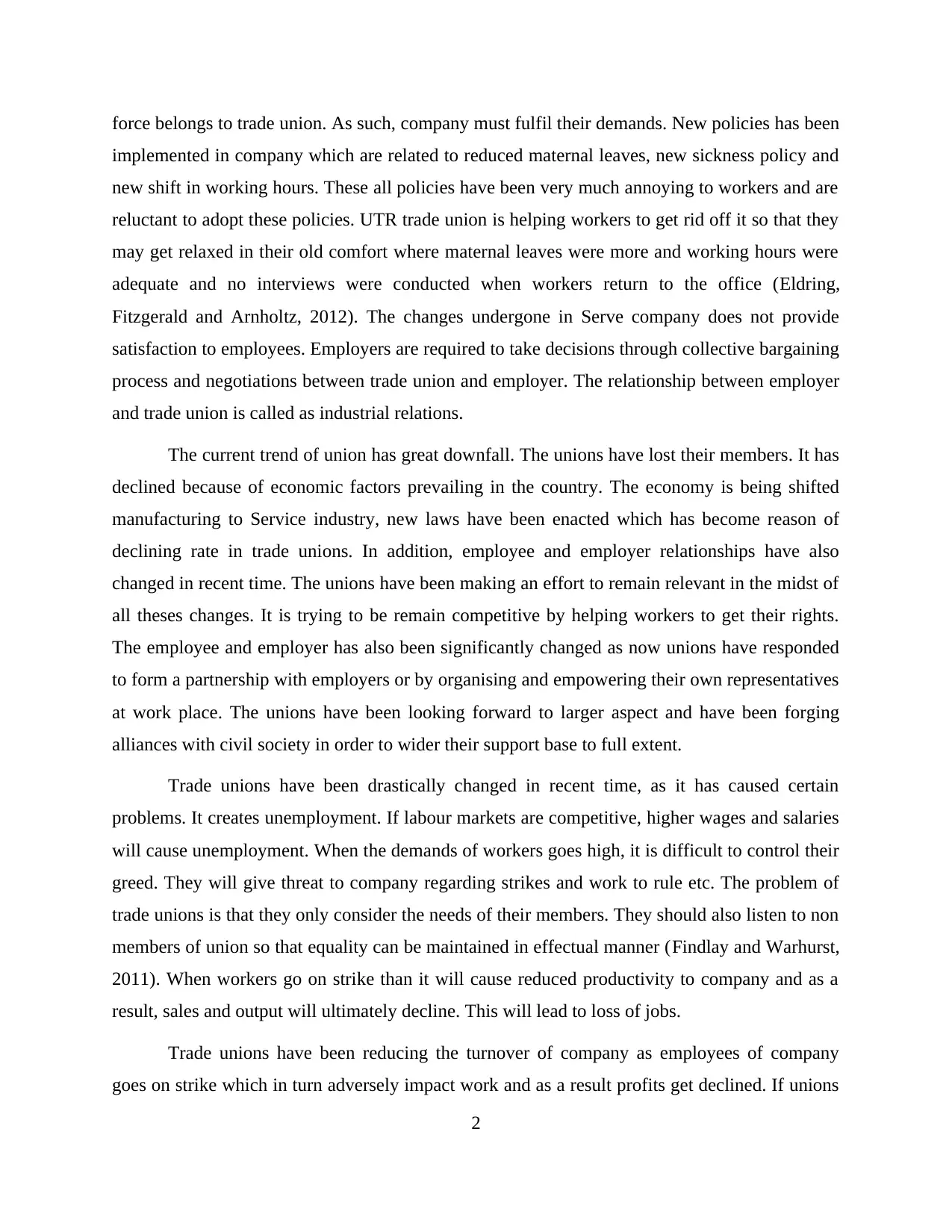
force belongs to trade union. As such, company must fulfil their demands. New policies has been
implemented in company which are related to reduced maternal leaves, new sickness policy and
new shift in working hours. These all policies have been very much annoying to workers and are
reluctant to adopt these policies. UTR trade union is helping workers to get rid off it so that they
may get relaxed in their old comfort where maternal leaves were more and working hours were
adequate and no interviews were conducted when workers return to the office (Eldring,
Fitzgerald and Arnholtz, 2012). The changes undergone in Serve company does not provide
satisfaction to employees. Employers are required to take decisions through collective bargaining
process and negotiations between trade union and employer. The relationship between employer
and trade union is called as industrial relations.
The current trend of union has great downfall. The unions have lost their members. It has
declined because of economic factors prevailing in the country. The economy is being shifted
manufacturing to Service industry, new laws have been enacted which has become reason of
declining rate in trade unions. In addition, employee and employer relationships have also
changed in recent time. The unions have been making an effort to remain relevant in the midst of
all theses changes. It is trying to be remain competitive by helping workers to get their rights.
The employee and employer has also been significantly changed as now unions have responded
to form a partnership with employers or by organising and empowering their own representatives
at work place. The unions have been looking forward to larger aspect and have been forging
alliances with civil society in order to wider their support base to full extent.
Trade unions have been drastically changed in recent time, as it has caused certain
problems. It creates unemployment. If labour markets are competitive, higher wages and salaries
will cause unemployment. When the demands of workers goes high, it is difficult to control their
greed. They will give threat to company regarding strikes and work to rule etc. The problem of
trade unions is that they only consider the needs of their members. They should also listen to non
members of union so that equality can be maintained in effectual manner (Findlay and Warhurst,
2011). When workers go on strike than it will cause reduced productivity to company and as a
result, sales and output will ultimately decline. This will lead to loss of jobs.
Trade unions have been reducing the turnover of company as employees of company
goes on strike which in turn adversely impact work and as a result profits get declined. If unions
2
implemented in company which are related to reduced maternal leaves, new sickness policy and
new shift in working hours. These all policies have been very much annoying to workers and are
reluctant to adopt these policies. UTR trade union is helping workers to get rid off it so that they
may get relaxed in their old comfort where maternal leaves were more and working hours were
adequate and no interviews were conducted when workers return to the office (Eldring,
Fitzgerald and Arnholtz, 2012). The changes undergone in Serve company does not provide
satisfaction to employees. Employers are required to take decisions through collective bargaining
process and negotiations between trade union and employer. The relationship between employer
and trade union is called as industrial relations.
The current trend of union has great downfall. The unions have lost their members. It has
declined because of economic factors prevailing in the country. The economy is being shifted
manufacturing to Service industry, new laws have been enacted which has become reason of
declining rate in trade unions. In addition, employee and employer relationships have also
changed in recent time. The unions have been making an effort to remain relevant in the midst of
all theses changes. It is trying to be remain competitive by helping workers to get their rights.
The employee and employer has also been significantly changed as now unions have responded
to form a partnership with employers or by organising and empowering their own representatives
at work place. The unions have been looking forward to larger aspect and have been forging
alliances with civil society in order to wider their support base to full extent.
Trade unions have been drastically changed in recent time, as it has caused certain
problems. It creates unemployment. If labour markets are competitive, higher wages and salaries
will cause unemployment. When the demands of workers goes high, it is difficult to control their
greed. They will give threat to company regarding strikes and work to rule etc. The problem of
trade unions is that they only consider the needs of their members. They should also listen to non
members of union so that equality can be maintained in effectual manner (Findlay and Warhurst,
2011). When workers go on strike than it will cause reduced productivity to company and as a
result, sales and output will ultimately decline. This will lead to loss of jobs.
Trade unions have been reducing the turnover of company as employees of company
goes on strike which in turn adversely impact work and as a result profits get declined. If unions
2
Paraphrase This Document
Need a fresh take? Get an instant paraphrase of this document with our AI Paraphraser
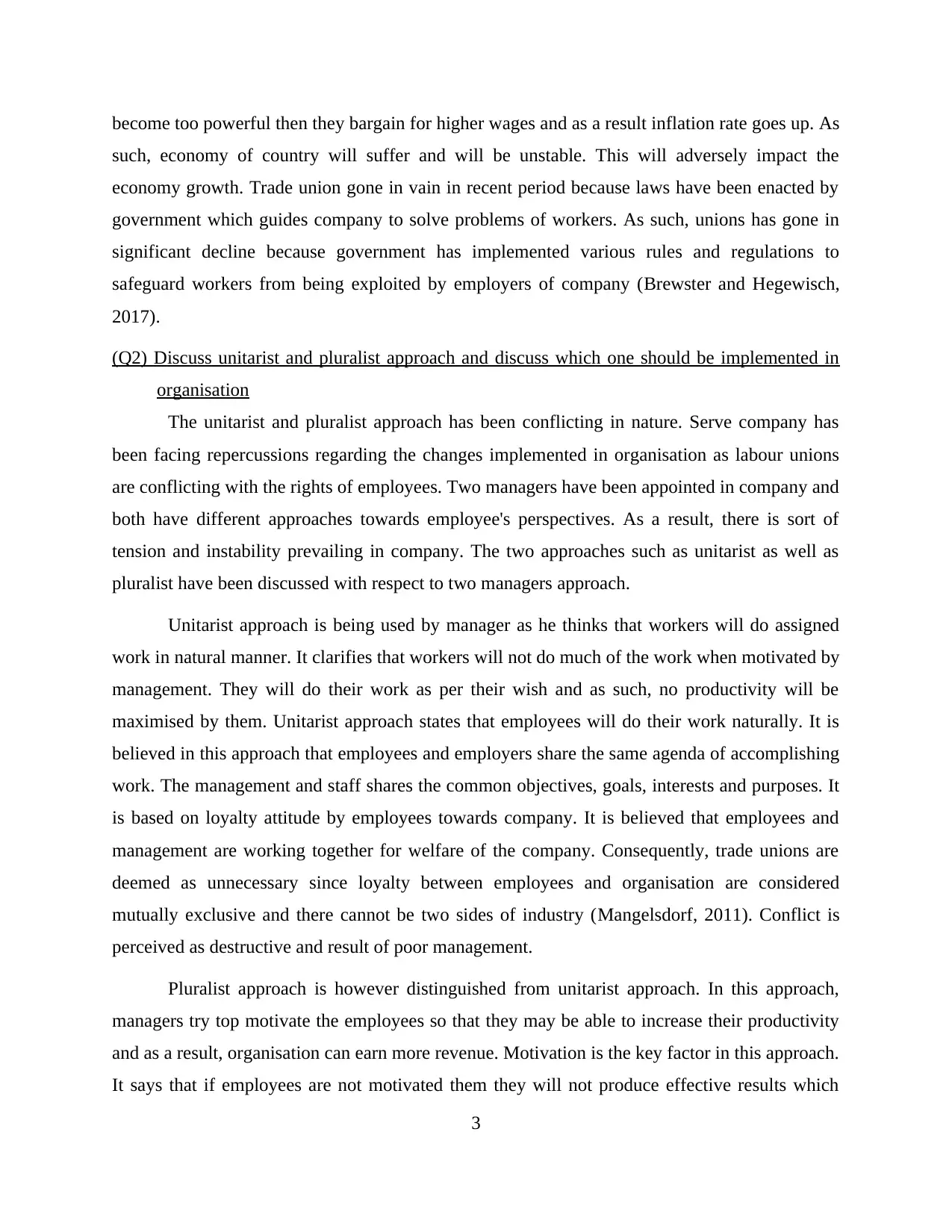
become too powerful then they bargain for higher wages and as a result inflation rate goes up. As
such, economy of country will suffer and will be unstable. This will adversely impact the
economy growth. Trade union gone in vain in recent period because laws have been enacted by
government which guides company to solve problems of workers. As such, unions has gone in
significant decline because government has implemented various rules and regulations to
safeguard workers from being exploited by employers of company (Brewster and Hegewisch,
2017).
(Q2) Discuss unitarist and pluralist approach and discuss which one should be implemented in
organisation
The unitarist and pluralist approach has been conflicting in nature. Serve company has
been facing repercussions regarding the changes implemented in organisation as labour unions
are conflicting with the rights of employees. Two managers have been appointed in company and
both have different approaches towards employee's perspectives. As a result, there is sort of
tension and instability prevailing in company. The two approaches such as unitarist as well as
pluralist have been discussed with respect to two managers approach.
Unitarist approach is being used by manager as he thinks that workers will do assigned
work in natural manner. It clarifies that workers will not do much of the work when motivated by
management. They will do their work as per their wish and as such, no productivity will be
maximised by them. Unitarist approach states that employees will do their work naturally. It is
believed in this approach that employees and employers share the same agenda of accomplishing
work. The management and staff shares the common objectives, goals, interests and purposes. It
is based on loyalty attitude by employees towards company. It is believed that employees and
management are working together for welfare of the company. Consequently, trade unions are
deemed as unnecessary since loyalty between employees and organisation are considered
mutually exclusive and there cannot be two sides of industry (Mangelsdorf, 2011). Conflict is
perceived as destructive and result of poor management.
Pluralist approach is however distinguished from unitarist approach. In this approach,
managers try top motivate the employees so that they may be able to increase their productivity
and as a result, organisation can earn more revenue. Motivation is the key factor in this approach.
It says that if employees are not motivated them they will not produce effective results which
3
such, economy of country will suffer and will be unstable. This will adversely impact the
economy growth. Trade union gone in vain in recent period because laws have been enacted by
government which guides company to solve problems of workers. As such, unions has gone in
significant decline because government has implemented various rules and regulations to
safeguard workers from being exploited by employers of company (Brewster and Hegewisch,
2017).
(Q2) Discuss unitarist and pluralist approach and discuss which one should be implemented in
organisation
The unitarist and pluralist approach has been conflicting in nature. Serve company has
been facing repercussions regarding the changes implemented in organisation as labour unions
are conflicting with the rights of employees. Two managers have been appointed in company and
both have different approaches towards employee's perspectives. As a result, there is sort of
tension and instability prevailing in company. The two approaches such as unitarist as well as
pluralist have been discussed with respect to two managers approach.
Unitarist approach is being used by manager as he thinks that workers will do assigned
work in natural manner. It clarifies that workers will not do much of the work when motivated by
management. They will do their work as per their wish and as such, no productivity will be
maximised by them. Unitarist approach states that employees will do their work naturally. It is
believed in this approach that employees and employers share the same agenda of accomplishing
work. The management and staff shares the common objectives, goals, interests and purposes. It
is based on loyalty attitude by employees towards company. It is believed that employees and
management are working together for welfare of the company. Consequently, trade unions are
deemed as unnecessary since loyalty between employees and organisation are considered
mutually exclusive and there cannot be two sides of industry (Mangelsdorf, 2011). Conflict is
perceived as destructive and result of poor management.
Pluralist approach is however distinguished from unitarist approach. In this approach,
managers try top motivate the employees so that they may be able to increase their productivity
and as a result, organisation can earn more revenue. Motivation is the key factor in this approach.
It says that if employees are not motivated them they will not produce effective results which
3
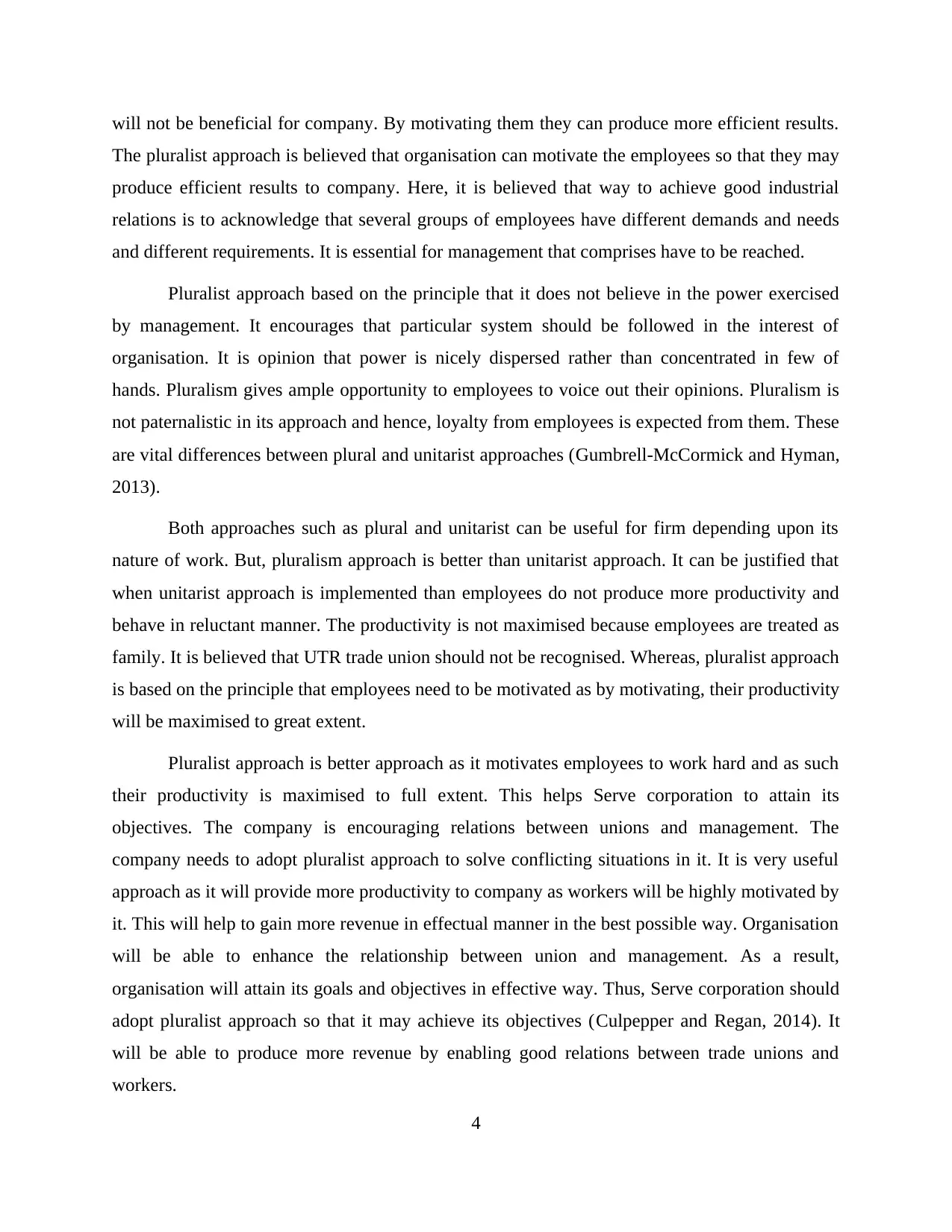
will not be beneficial for company. By motivating them they can produce more efficient results.
The pluralist approach is believed that organisation can motivate the employees so that they may
produce efficient results to company. Here, it is believed that way to achieve good industrial
relations is to acknowledge that several groups of employees have different demands and needs
and different requirements. It is essential for management that comprises have to be reached.
Pluralist approach based on the principle that it does not believe in the power exercised
by management. It encourages that particular system should be followed in the interest of
organisation. It is opinion that power is nicely dispersed rather than concentrated in few of
hands. Pluralism gives ample opportunity to employees to voice out their opinions. Pluralism is
not paternalistic in its approach and hence, loyalty from employees is expected from them. These
are vital differences between plural and unitarist approaches (Gumbrell-McCormick and Hyman,
2013).
Both approaches such as plural and unitarist can be useful for firm depending upon its
nature of work. But, pluralism approach is better than unitarist approach. It can be justified that
when unitarist approach is implemented than employees do not produce more productivity and
behave in reluctant manner. The productivity is not maximised because employees are treated as
family. It is believed that UTR trade union should not be recognised. Whereas, pluralist approach
is based on the principle that employees need to be motivated as by motivating, their productivity
will be maximised to great extent.
Pluralist approach is better approach as it motivates employees to work hard and as such
their productivity is maximised to full extent. This helps Serve corporation to attain its
objectives. The company is encouraging relations between unions and management. The
company needs to adopt pluralist approach to solve conflicting situations in it. It is very useful
approach as it will provide more productivity to company as workers will be highly motivated by
it. This will help to gain more revenue in effectual manner in the best possible way. Organisation
will be able to enhance the relationship between union and management. As a result,
organisation will attain its goals and objectives in effective way. Thus, Serve corporation should
adopt pluralist approach so that it may achieve its objectives (Culpepper and Regan, 2014). It
will be able to produce more revenue by enabling good relations between trade unions and
workers.
4
The pluralist approach is believed that organisation can motivate the employees so that they may
produce efficient results to company. Here, it is believed that way to achieve good industrial
relations is to acknowledge that several groups of employees have different demands and needs
and different requirements. It is essential for management that comprises have to be reached.
Pluralist approach based on the principle that it does not believe in the power exercised
by management. It encourages that particular system should be followed in the interest of
organisation. It is opinion that power is nicely dispersed rather than concentrated in few of
hands. Pluralism gives ample opportunity to employees to voice out their opinions. Pluralism is
not paternalistic in its approach and hence, loyalty from employees is expected from them. These
are vital differences between plural and unitarist approaches (Gumbrell-McCormick and Hyman,
2013).
Both approaches such as plural and unitarist can be useful for firm depending upon its
nature of work. But, pluralism approach is better than unitarist approach. It can be justified that
when unitarist approach is implemented than employees do not produce more productivity and
behave in reluctant manner. The productivity is not maximised because employees are treated as
family. It is believed that UTR trade union should not be recognised. Whereas, pluralist approach
is based on the principle that employees need to be motivated as by motivating, their productivity
will be maximised to great extent.
Pluralist approach is better approach as it motivates employees to work hard and as such
their productivity is maximised to full extent. This helps Serve corporation to attain its
objectives. The company is encouraging relations between unions and management. The
company needs to adopt pluralist approach to solve conflicting situations in it. It is very useful
approach as it will provide more productivity to company as workers will be highly motivated by
it. This will help to gain more revenue in effectual manner in the best possible way. Organisation
will be able to enhance the relationship between union and management. As a result,
organisation will attain its goals and objectives in effective way. Thus, Serve corporation should
adopt pluralist approach so that it may achieve its objectives (Culpepper and Regan, 2014). It
will be able to produce more revenue by enabling good relations between trade unions and
workers.
4
⊘ This is a preview!⊘
Do you want full access?
Subscribe today to unlock all pages.

Trusted by 1+ million students worldwide
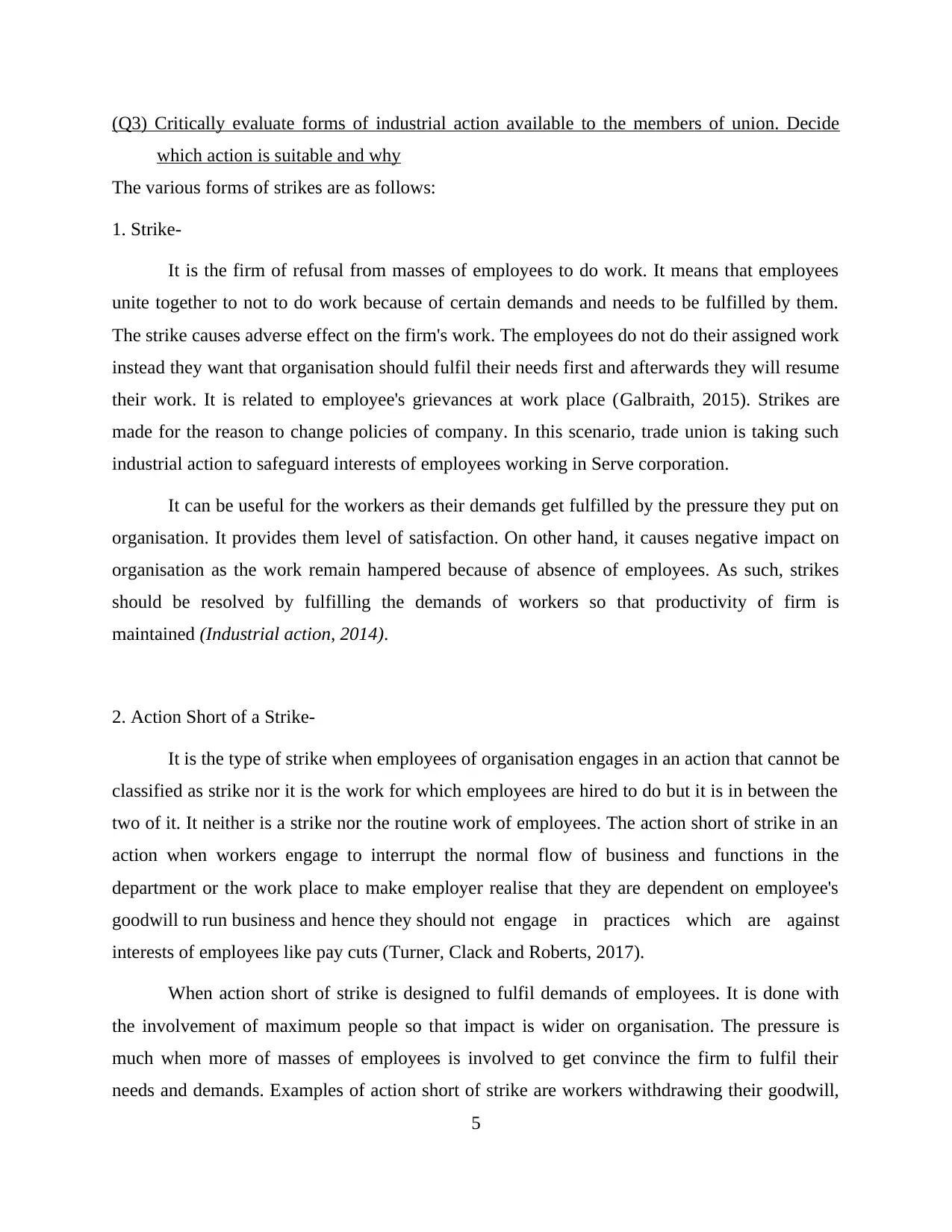
(Q3) Critically evaluate forms of industrial action available to the members of union. Decide
which action is suitable and why
The various forms of strikes are as follows:
1. Strike-
It is the firm of refusal from masses of employees to do work. It means that employees
unite together to not to do work because of certain demands and needs to be fulfilled by them.
The strike causes adverse effect on the firm's work. The employees do not do their assigned work
instead they want that organisation should fulfil their needs first and afterwards they will resume
their work. It is related to employee's grievances at work place (Galbraith, 2015). Strikes are
made for the reason to change policies of company. In this scenario, trade union is taking such
industrial action to safeguard interests of employees working in Serve corporation.
It can be useful for the workers as their demands get fulfilled by the pressure they put on
organisation. It provides them level of satisfaction. On other hand, it causes negative impact on
organisation as the work remain hampered because of absence of employees. As such, strikes
should be resolved by fulfilling the demands of workers so that productivity of firm is
maintained (Industrial action, 2014).
2. Action Short of a Strike-
It is the type of strike when employees of organisation engages in an action that cannot be
classified as strike nor it is the work for which employees are hired to do but it is in between the
two of it. It neither is a strike nor the routine work of employees. The action short of strike in an
action when workers engage to interrupt the normal flow of business and functions in the
department or the work place to make employer realise that they are dependent on employee's
goodwill to run business and hence they should not engage in practices which are against
interests of employees like pay cuts (Turner, Clack and Roberts, 2017).
When action short of strike is designed to fulfil demands of employees. It is done with
the involvement of maximum people so that impact is wider on organisation. The pressure is
much when more of masses of employees is involved to get convince the firm to fulfil their
needs and demands. Examples of action short of strike are workers withdrawing their goodwill,
5
which action is suitable and why
The various forms of strikes are as follows:
1. Strike-
It is the firm of refusal from masses of employees to do work. It means that employees
unite together to not to do work because of certain demands and needs to be fulfilled by them.
The strike causes adverse effect on the firm's work. The employees do not do their assigned work
instead they want that organisation should fulfil their needs first and afterwards they will resume
their work. It is related to employee's grievances at work place (Galbraith, 2015). Strikes are
made for the reason to change policies of company. In this scenario, trade union is taking such
industrial action to safeguard interests of employees working in Serve corporation.
It can be useful for the workers as their demands get fulfilled by the pressure they put on
organisation. It provides them level of satisfaction. On other hand, it causes negative impact on
organisation as the work remain hampered because of absence of employees. As such, strikes
should be resolved by fulfilling the demands of workers so that productivity of firm is
maintained (Industrial action, 2014).
2. Action Short of a Strike-
It is the type of strike when employees of organisation engages in an action that cannot be
classified as strike nor it is the work for which employees are hired to do but it is in between the
two of it. It neither is a strike nor the routine work of employees. The action short of strike in an
action when workers engage to interrupt the normal flow of business and functions in the
department or the work place to make employer realise that they are dependent on employee's
goodwill to run business and hence they should not engage in practices which are against
interests of employees like pay cuts (Turner, Clack and Roberts, 2017).
When action short of strike is designed to fulfil demands of employees. It is done with
the involvement of maximum people so that impact is wider on organisation. The pressure is
much when more of masses of employees is involved to get convince the firm to fulfil their
needs and demands. Examples of action short of strike are workers withdrawing their goodwill,
5
Paraphrase This Document
Need a fresh take? Get an instant paraphrase of this document with our AI Paraphraser
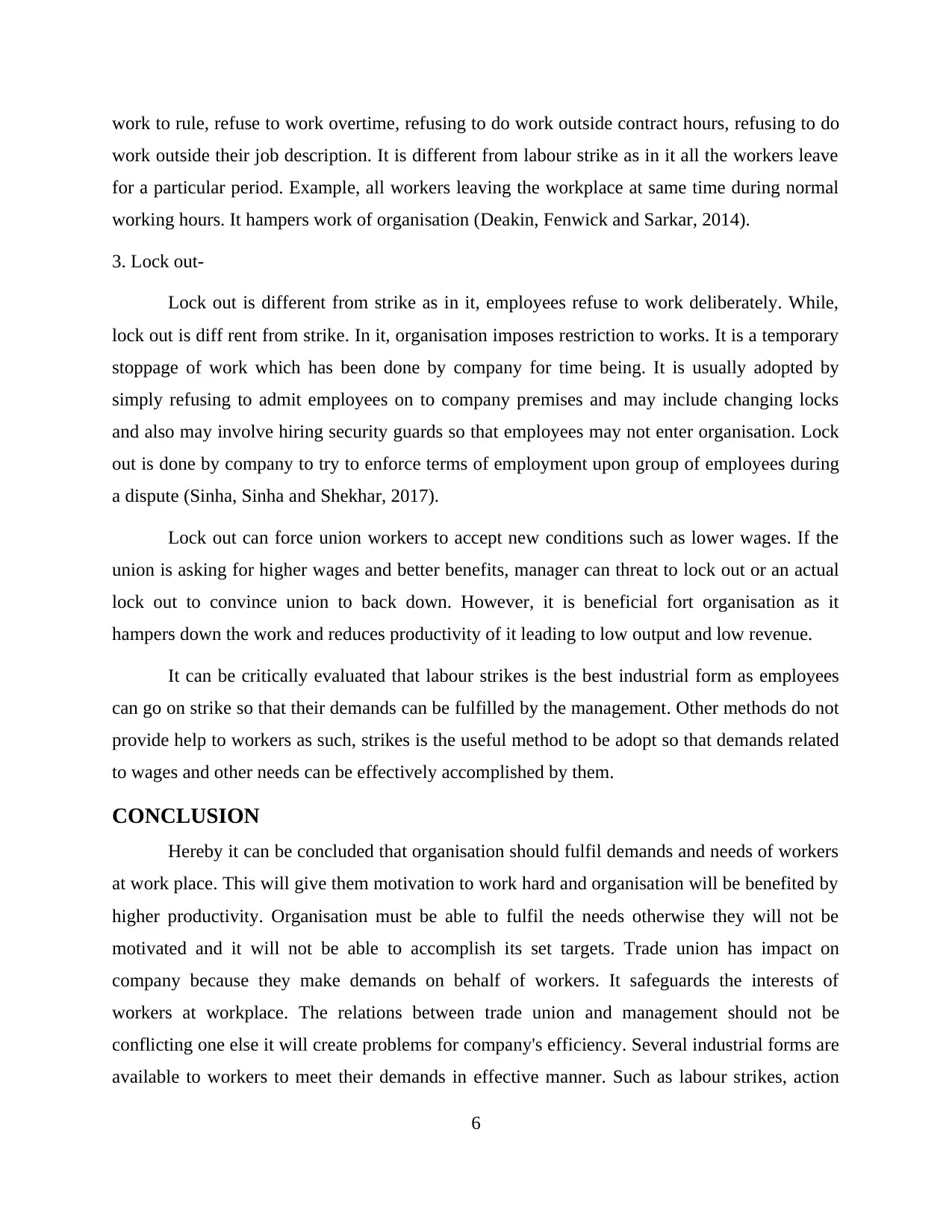
work to rule, refuse to work overtime, refusing to do work outside contract hours, refusing to do
work outside their job description. It is different from labour strike as in it all the workers leave
for a particular period. Example, all workers leaving the workplace at same time during normal
working hours. It hampers work of organisation (Deakin, Fenwick and Sarkar, 2014).
3. Lock out-
Lock out is different from strike as in it, employees refuse to work deliberately. While,
lock out is diff rent from strike. In it, organisation imposes restriction to works. It is a temporary
stoppage of work which has been done by company for time being. It is usually adopted by
simply refusing to admit employees on to company premises and may include changing locks
and also may involve hiring security guards so that employees may not enter organisation. Lock
out is done by company to try to enforce terms of employment upon group of employees during
a dispute (Sinha, Sinha and Shekhar, 2017).
Lock out can force union workers to accept new conditions such as lower wages. If the
union is asking for higher wages and better benefits, manager can threat to lock out or an actual
lock out to convince union to back down. However, it is beneficial fort organisation as it
hampers down the work and reduces productivity of it leading to low output and low revenue.
It can be critically evaluated that labour strikes is the best industrial form as employees
can go on strike so that their demands can be fulfilled by the management. Other methods do not
provide help to workers as such, strikes is the useful method to be adopt so that demands related
to wages and other needs can be effectively accomplished by them.
CONCLUSION
Hereby it can be concluded that organisation should fulfil demands and needs of workers
at work place. This will give them motivation to work hard and organisation will be benefited by
higher productivity. Organisation must be able to fulfil the needs otherwise they will not be
motivated and it will not be able to accomplish its set targets. Trade union has impact on
company because they make demands on behalf of workers. It safeguards the interests of
workers at workplace. The relations between trade union and management should not be
conflicting one else it will create problems for company's efficiency. Several industrial forms are
available to workers to meet their demands in effective manner. Such as labour strikes, action
6
work outside their job description. It is different from labour strike as in it all the workers leave
for a particular period. Example, all workers leaving the workplace at same time during normal
working hours. It hampers work of organisation (Deakin, Fenwick and Sarkar, 2014).
3. Lock out-
Lock out is different from strike as in it, employees refuse to work deliberately. While,
lock out is diff rent from strike. In it, organisation imposes restriction to works. It is a temporary
stoppage of work which has been done by company for time being. It is usually adopted by
simply refusing to admit employees on to company premises and may include changing locks
and also may involve hiring security guards so that employees may not enter organisation. Lock
out is done by company to try to enforce terms of employment upon group of employees during
a dispute (Sinha, Sinha and Shekhar, 2017).
Lock out can force union workers to accept new conditions such as lower wages. If the
union is asking for higher wages and better benefits, manager can threat to lock out or an actual
lock out to convince union to back down. However, it is beneficial fort organisation as it
hampers down the work and reduces productivity of it leading to low output and low revenue.
It can be critically evaluated that labour strikes is the best industrial form as employees
can go on strike so that their demands can be fulfilled by the management. Other methods do not
provide help to workers as such, strikes is the useful method to be adopt so that demands related
to wages and other needs can be effectively accomplished by them.
CONCLUSION
Hereby it can be concluded that organisation should fulfil demands and needs of workers
at work place. This will give them motivation to work hard and organisation will be benefited by
higher productivity. Organisation must be able to fulfil the needs otherwise they will not be
motivated and it will not be able to accomplish its set targets. Trade union has impact on
company because they make demands on behalf of workers. It safeguards the interests of
workers at workplace. The relations between trade union and management should not be
conflicting one else it will create problems for company's efficiency. Several industrial forms are
available to workers to meet their demands in effective manner. Such as labour strikes, action
6
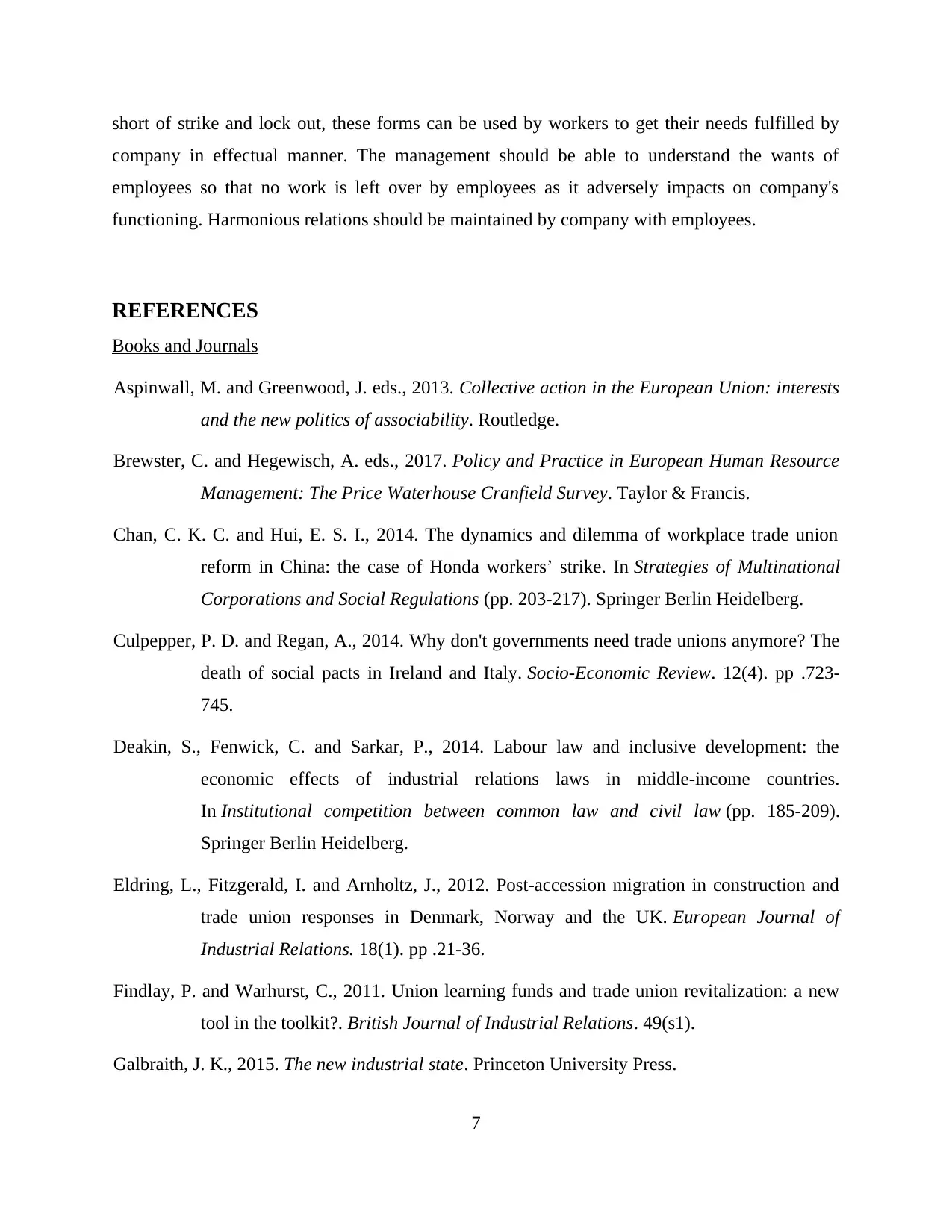
short of strike and lock out, these forms can be used by workers to get their needs fulfilled by
company in effectual manner. The management should be able to understand the wants of
employees so that no work is left over by employees as it adversely impacts on company's
functioning. Harmonious relations should be maintained by company with employees.
REFERENCES
Books and Journals
Aspinwall, M. and Greenwood, J. eds., 2013. Collective action in the European Union: interests
and the new politics of associability. Routledge.
Brewster, C. and Hegewisch, A. eds., 2017. Policy and Practice in European Human Resource
Management: The Price Waterhouse Cranfield Survey. Taylor & Francis.
Chan, C. K. C. and Hui, E. S. I., 2014. The dynamics and dilemma of workplace trade union
reform in China: the case of Honda workers’ strike. In Strategies of Multinational
Corporations and Social Regulations (pp. 203-217). Springer Berlin Heidelberg.
Culpepper, P. D. and Regan, A., 2014. Why don't governments need trade unions anymore? The
death of social pacts in Ireland and Italy. Socio-Economic Review. 12(4). pp .723-
745.
Deakin, S., Fenwick, C. and Sarkar, P., 2014. Labour law and inclusive development: the
economic effects of industrial relations laws in middle-income countries.
In Institutional competition between common law and civil law (pp. 185-209).
Springer Berlin Heidelberg.
Eldring, L., Fitzgerald, I. and Arnholtz, J., 2012. Post-accession migration in construction and
trade union responses in Denmark, Norway and the UK. European Journal of
Industrial Relations. 18(1). pp .21-36.
Findlay, P. and Warhurst, C., 2011. Union learning funds and trade union revitalization: a new
tool in the toolkit?. British Journal of Industrial Relations. 49(s1).
Galbraith, J. K., 2015. The new industrial state. Princeton University Press.
7
company in effectual manner. The management should be able to understand the wants of
employees so that no work is left over by employees as it adversely impacts on company's
functioning. Harmonious relations should be maintained by company with employees.
REFERENCES
Books and Journals
Aspinwall, M. and Greenwood, J. eds., 2013. Collective action in the European Union: interests
and the new politics of associability. Routledge.
Brewster, C. and Hegewisch, A. eds., 2017. Policy and Practice in European Human Resource
Management: The Price Waterhouse Cranfield Survey. Taylor & Francis.
Chan, C. K. C. and Hui, E. S. I., 2014. The dynamics and dilemma of workplace trade union
reform in China: the case of Honda workers’ strike. In Strategies of Multinational
Corporations and Social Regulations (pp. 203-217). Springer Berlin Heidelberg.
Culpepper, P. D. and Regan, A., 2014. Why don't governments need trade unions anymore? The
death of social pacts in Ireland and Italy. Socio-Economic Review. 12(4). pp .723-
745.
Deakin, S., Fenwick, C. and Sarkar, P., 2014. Labour law and inclusive development: the
economic effects of industrial relations laws in middle-income countries.
In Institutional competition between common law and civil law (pp. 185-209).
Springer Berlin Heidelberg.
Eldring, L., Fitzgerald, I. and Arnholtz, J., 2012. Post-accession migration in construction and
trade union responses in Denmark, Norway and the UK. European Journal of
Industrial Relations. 18(1). pp .21-36.
Findlay, P. and Warhurst, C., 2011. Union learning funds and trade union revitalization: a new
tool in the toolkit?. British Journal of Industrial Relations. 49(s1).
Galbraith, J. K., 2015. The new industrial state. Princeton University Press.
7
⊘ This is a preview!⊘
Do you want full access?
Subscribe today to unlock all pages.

Trusted by 1+ million students worldwide
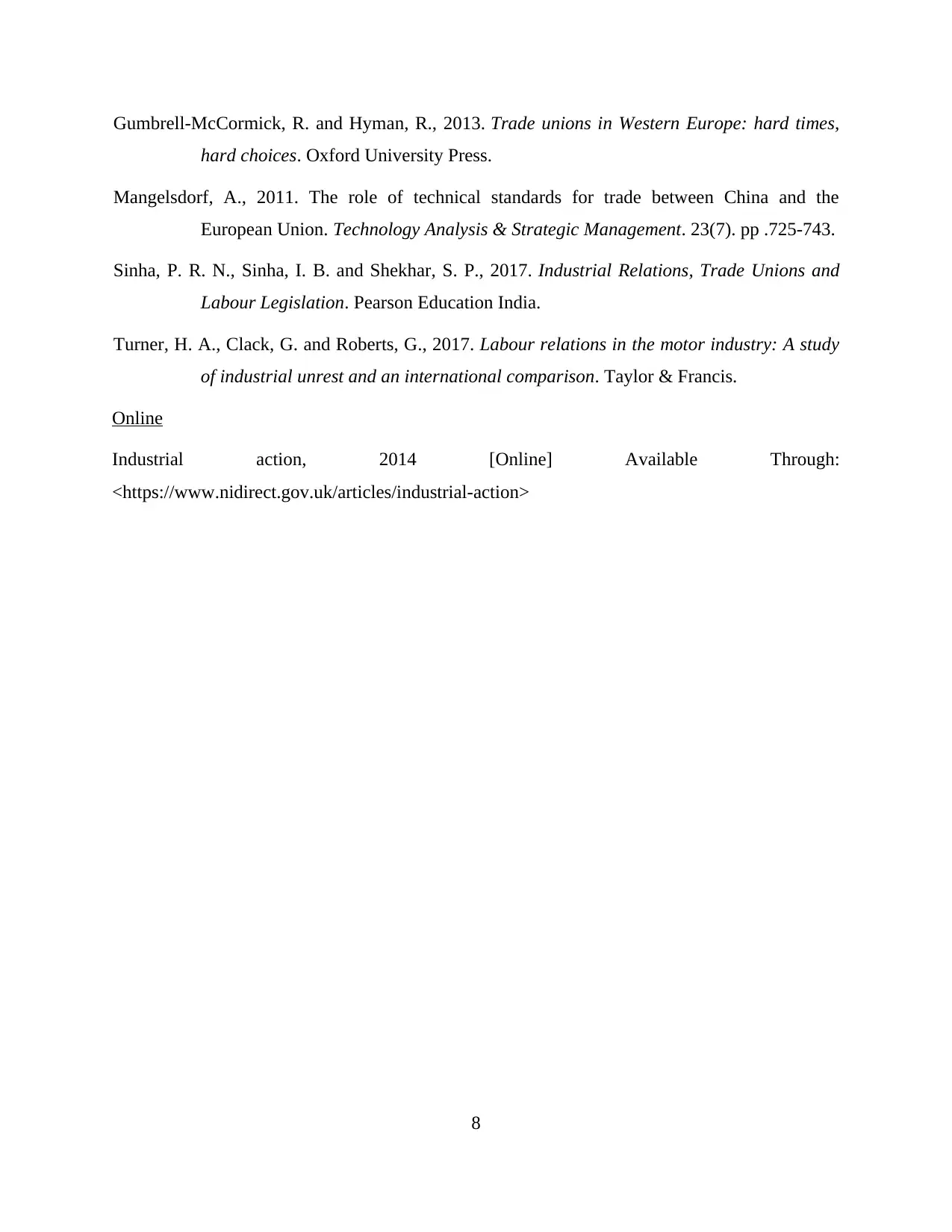
Gumbrell-McCormick, R. and Hyman, R., 2013. Trade unions in Western Europe: hard times,
hard choices. Oxford University Press.
Mangelsdorf, A., 2011. The role of technical standards for trade between China and the
European Union. Technology Analysis & Strategic Management. 23(7). pp .725-743.
Sinha, P. R. N., Sinha, I. B. and Shekhar, S. P., 2017. Industrial Relations, Trade Unions and
Labour Legislation. Pearson Education India.
Turner, H. A., Clack, G. and Roberts, G., 2017. Labour relations in the motor industry: A study
of industrial unrest and an international comparison. Taylor & Francis.
Online
Industrial action, 2014 [Online] Available Through:
<https://www.nidirect.gov.uk/articles/industrial-action>
8
hard choices. Oxford University Press.
Mangelsdorf, A., 2011. The role of technical standards for trade between China and the
European Union. Technology Analysis & Strategic Management. 23(7). pp .725-743.
Sinha, P. R. N., Sinha, I. B. and Shekhar, S. P., 2017. Industrial Relations, Trade Unions and
Labour Legislation. Pearson Education India.
Turner, H. A., Clack, G. and Roberts, G., 2017. Labour relations in the motor industry: A study
of industrial unrest and an international comparison. Taylor & Francis.
Online
Industrial action, 2014 [Online] Available Through:
<https://www.nidirect.gov.uk/articles/industrial-action>
8
1 out of 10
Related Documents
Your All-in-One AI-Powered Toolkit for Academic Success.
+13062052269
info@desklib.com
Available 24*7 on WhatsApp / Email
![[object Object]](/_next/static/media/star-bottom.7253800d.svg)
Unlock your academic potential
Copyright © 2020–2025 A2Z Services. All Rights Reserved. Developed and managed by ZUCOL.





